Chromatography Quiz #38 — Troubleshooting High Pressure — Winners
Pickering Labs would like to congratulate all of our winners for our previous newsletter’s Chromatography Quiz:

Josiah Hakala from Minnesota Department of Health, Tom Schneider from Suffolk County Water Authority, and Narjes Ghafoori from Los Angeles County Public Health Laboratory.
Winners will soon receive a Pumpkin-Shaped Gift Basket! Includes an assortment of baked goodies, sweet treats, and a bottle of red blend wine! ($99 value) Happy Autumn!
Congratulations to our quiz winners!
Thank you all for your submissions!
The correct answer to the Troubleshooting High Pressure Quiz was beautifully summarized by Tom:
The blockage is located between the union and the inlet to the detector. The largest pressure drop occurs when the outlet of the union is disconnected. Since the inlet to the detector does not show a significant decrease in pressure, the tubing that connects the union to the detector is the cause of the high back pressure and should be replaced.
Chromatography Quiz #39 – Rising Baseline
What is causing the Carbamates baseline to rise? Below you will find a reference chromatogram, HPLC gradient table, and bad chromatogram.
Bad Chromatogram
Good Chromatogram
Correctly identify the chromatography issue and win a prize! Simply email your answer and your full contact information to Rebecca at rsmith@pickeringlabs.com by November 30, 2021 in order to win. You will receive email confirmation when your submission is received, and the troubleshooting answer and winner congratulations will be published in the next issue (to be anonymous, please notify Rebecca in submission).
If you have difficulty reading the images for Quiz #39, please click on them to enlarge or contact David Mazawa below to obtain a more user friendly PDF.
David Mazawa
Technical Support Chemist
Pickering Laboratories, Inc.
1280 Space Park Way
Mountain View, CA 94043, USA
david@pickeringlabs.com
Phone: (650) 694-6700 x710

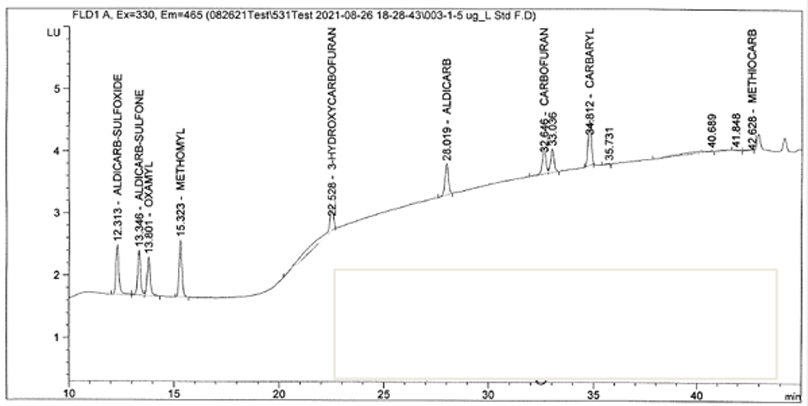


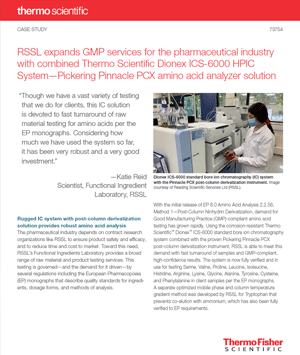
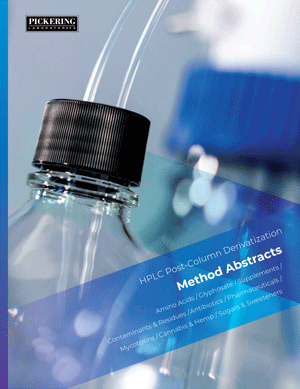 A New Method Abstract Brochure from Pickering Laboratories!
A New Method Abstract Brochure from Pickering Laboratories! Increasing Awareness of Nitrosamines Contamination in Water and Pharmaceuticals
Increasing Awareness of Nitrosamines Contamination in Water and Pharmaceuticals Apocrine glands are a member of the sweat gland family. Although present from birth, apocrine glands become active during puberty and start to produce apocrine sweat. This sweat is composed of proteins, carbohydrates, fatty acids, steroids, lipids electrolytes, and nitrogen metabolites such as ammonia and urea. Apocrine sweat is initially sterile and odorless but when acted upon by commensal bacteria present in the axilla region, it produces the malodor compounds responsible for the human axillary odor.
Apocrine glands are a member of the sweat gland family. Although present from birth, apocrine glands become active during puberty and start to produce apocrine sweat. This sweat is composed of proteins, carbohydrates, fatty acids, steroids, lipids electrolytes, and nitrogen metabolites such as ammonia and urea. Apocrine sweat is initially sterile and odorless but when acted upon by commensal bacteria present in the axilla region, it produces the malodor compounds responsible for the human axillary odor.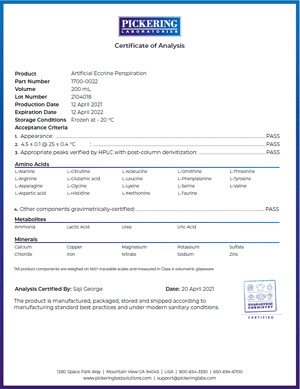 Pickering Laboratories introduces improved Certificate of Analysis for Artificial Body Fluids products
Pickering Laboratories introduces improved Certificate of Analysis for Artificial Body Fluids products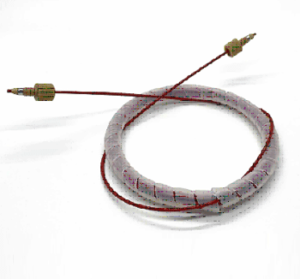 After recent research demonstrating enhanced performance capabilities, we are now offering replacements for our previous style of flow restrictors. See the two notices regarding the new style of flow restrictors used for the Vector PCX.
After recent research demonstrating enhanced performance capabilities, we are now offering replacements for our previous style of flow restrictors. See the two notices regarding the new style of flow restrictors used for the Vector PCX.